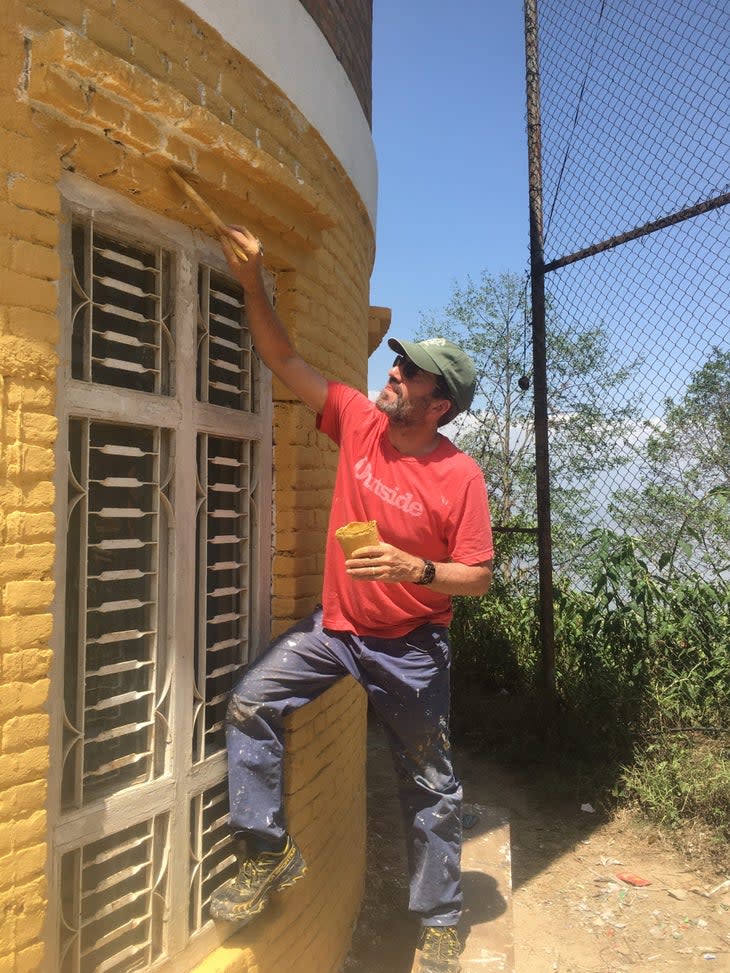Hike and Help in Nepal With Backpacker
Backpacker
The last two years have been a challenge for everyone--but that's especially true for the people of Nepal, who have seen the trekking economy crash in addition to other pandemic stresses. That's why Backpacker brought a group there last spring, and why we're going back in the fall. We're supporting Nepal's recovery with a trip that's half volunteer effort, half trekking, and all fun.
What's that mean? The first week is devoted to a service project. This fall, we'll be helping a Nepal-based nonprofit build a much-needed health clinic in the village of Kakani, in the hills outside of Kathmandu. No skills are required--just a willingness to put some sweat equity into a much-needed clinic--and we're making a $500 donation to the project on behalf of every participant.
The second week we'll embark on a nine-day trek in the Nar Phu valley, a remote region between Annapurna and the Tibetan border. There, we'll stay in villages that were settled centuries ago by Tibetan communities, visit Buddhist monasteries, and have the opportunity to cross a 17,400-foot pass. The Nar Phu region has no reliable electricity, so we'll also distribute solar-powered lanterns to families along the route. We partner with Wildland Trekking and use Nepali guides and porters, and while Himalayan hiking is always challenging, anyone in good shape can do this trek.
It's the ultimate win-win adventure. The fall 2022 trip is October 28 – November 16, and space is limited. Learn more and register.
How can you tell if this trip is for you? Easy, just see if these apply.
You want to make a tangible contribution.
In Nepal, GDP per capita was $1,222 in 2021, according to the World Bank. That makes it among the poorest countries in the world (for comparison, Haiti's per capita GDP was $1,814 in 2021.) With limited resources, Nepal often lacks critical infrastructure that we take for granted. In Kakani, that means hundreds of families have to travel to Kathmandu for medical services, a problem that was exacerbated by the pandemic. The health clinic we're helping to build will serve a rural community where many people don't have the means to travel when they're sick or injured.
While in Kakani, you'll meet the people who will benefit from the clinic and work alongside members of the community. You'll make a real contribution to construction (get ready to roll up those sleeves), and know that every ounce of sweat and dollar donated is going directly to a project that locals have said is their highest priority.

You want to experience the world's greatest mountains.
Nothing against the Rockies or Alps, but the Himalayas start where those mountains end. On the Nar Phu trek, we'll stay in villages above 13,000 feet, in the shadow of 20,000-foot peaks. On an optional day hike to Himlung Himal base camp, at 16,000 feet, we'll walk above a massive glacier. But it's not just the scale that makes the Himalayas so unique. It's also the people, who have mastered the art of living in some of the world's harshest conditions.


You want to deliver much-needed solar lights.
In the remote villages of the Himalayas, electricity is either nonexistent or spotty at best. That means the majority of people rely on oil lamps or fire for light, which are bad for the environment and the air quality, especially in small, poorly ventilated mountain homes. We partner with Mpowerd to bring Luci solar lanterns to these communities, equipping them with free, clean light.

You want to experience teahouse trekking.
We won't be sleeping on the ground or cooking dehydrated meals on this trek. Nepal's famously hospitable teahouse culture is something every hiker should experience. The Nar Phu Valley, which was off-limits to trekkers for decades, is relatively undeveloped, so lodging is basic compared to popular routes like Everest Base Camp and Annapurna. But you still get cozy rooms, homemade curries and momos, and hot tea morning, noon, and night.
You want to challenge yourself.
For most North American hikers, climbing a fourteener is about as high they'll ever get without boarding a plane. On this route, legs and lungs willing, we'll go more than 3,000 vertical feet higher. The 17,400-foot pass comes near the end of the trek, allowing plenty of time to acclimatize, but it's still a challenging day that takes most hikers 12 hours (there's an optional lower route if needed). The reward? Atop the pass, you'll come face-to-east-face with the Annapurna Range.

If this sounds like you, join us October 28 – November 16 for the trip of a lifetime. Learn more and register.
Special thanks to our gear sponsors, who outfitted the group with packs and water purifiers.
Gregory Stout 35 and Amber 34 packs proved ideal for Himayalan trekking: big enough for a full day's worth of layers, water, snacks, and camera gear, but light and comfortable to carry, which is welcome anytime but especially at altitude, when every step is harder.
Traveling in a developing country requires constant care when it comes to drinking water. Both in town and on the trail, water could be contaminated with any number of pathogens (virus, bacteria, protozoan cysts). The Grayl GeoPress Water Filter and Purifier Bottle eliminates those contaminants and filters pesticides, chemicals, heavy metals, and microplastics as well. Equipping our team with Grayl purifiers made it easy to treat water in every situation.
For exclusive access to all of our fitness, gear, adventure, and travel stories, plus discounts on trips, events, and gear, sign up for Outside+ today.]]>

